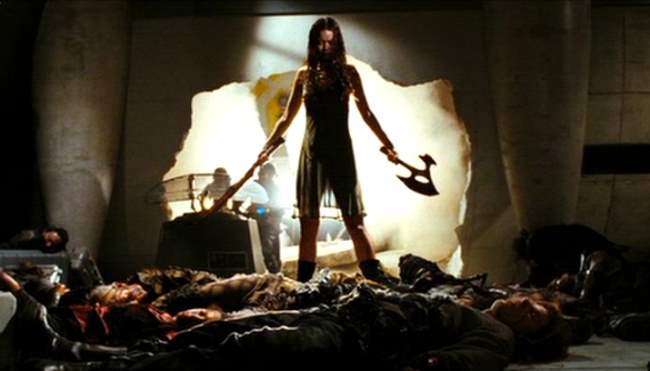Movie Review By: Dan Swensen
Year: 1981
Directed by: Michael Crichton
Written by: Michael Crichton
IMDB Reference
Degree of Cyberpunk Visuals: Low
Correlation to Cyberpunk Themes: Medium
Key Cast Members:
- Larry Roberts: Albert Finney
- Cindy Fairmont: Susan Dey
- John Reston: James Coburn

Uneven, satirical, and oddly prophetic in its own half-baked way, Michael Crichton’s 1981 film Looker takes place in a terrifying universe of glamour, dehumanization, corporate deception, and Susan Dey hooking up with Albert Finney.
SFAM NOTE: We welcome new reviewer Dan Swensen, who also runs a terrific Sci-Fi blog called the Dimfuture.net. If others are interested in joining the review team, please post a message in the review forum.
Overview: The year is 1981, and pudgy, befuddled plastic surgeon Larry Roberts (Finney) becomes involved in a mystery when one of his models, dissolved in tears, arrives in his office raving hysterically about mysterious people trying to kill her. Hours later, the model inexplicably falls from the window of her high-rise apartment, and evidence of foul play points to Roberts himself. Justifiably concerned, Roberts begins playing amateur detective, teaming up with his patient (the vapid and insecure Cindy Fairmont, played by Susan Dey) to find out what’s really happening to these models, who seem to be dying off in droves shortly after visiting Roberts’ office to be “perfected.”
Mostly relying on the incompetence of the antagonists and the near-complete apathy of the cops, Roberts eventually tracks the clues back to a company called Digital Matrix, a computer graphics and advertising firm that specializes in creating digital replicas of top commercial models. While these models are given lucrative contracts in exchange for their digital likenesses, they seem to mysteriously die shortly thereafter, their handsome royalties left unpaid. It doesn’t take long for Roberts to figure out that Digital Matrix is duplicating these models, then killing them off, as their “digital doubles” will do their job better — and for free.

Machines and Misogyny: In an age where digital replacement and enhancement of actors is now extremely commonplace, Looker seems both surprisingly relevant and woefully dated at the same time. Penned in by Hollywood’s desire for complete perfection, the models of Looker fret over millimeter-sized flaws, consumed with self-loathing over even the slightest imperfection. As the story progresses, the audience finds this to be more than mere vanity — in Crichton’s world, Digital Matrix has reduced human behavior to a set of algorithms, able to determine (and manipulate) the focus of a viewer’s attention with ultimate precision to maximize product exposure and desire.
Because these manipulations require inhuman accuracy, the models themselves soon become not only obsolete, but liabilities to the company. The theme of dehumanization — the models looked upon by the corporations, and themselves, not as human beings but commodities to be used up and thrown away — is very strong in the first half of the film, underlined by a casual misogyny that may or may not have been intentional (it was 1981, after all).

In addition to the prophetic “digital doubles” of the film, Looker’s most science-fiction invention is the L.O.O.K.E.R. device (short for Light Ocular-Oriented Kinetic Emotive Responses), a “light gun” that stuns and paralyzes the target using light. Anyone exposed to this weapon experiences a sort of “missing time” as they stand paralyzed, allowing the weapon’s user to move around, invisible and undetected, for short periods. Digital Matrix uses the device to cover their tracks, making the models’ deaths appear as suicides.
While Looker is more than a bit plodding at times, the film’s use of this device is undoubtedly the most clever effect in the film, as characters find themselves losing time without knowing how or why. (It’s also worth mentioning that the L.O.O.K.E.R. device is the movie’s only real special effect, and provides the film’s most interesting visuals.) The L.O.O.K.E.R. device is a neat little concept, one I wish could have gotten better treatment in a better film.

The Bottom Line: Unfortunately, Looker is a movie with a few good ideas that don’t quite survive the runtime. The last half-hour of the movie is an extended game of “humorous” cat-and-mouse in which the heroes and villains chase each other through a virtual landscape of digitized commercials — the best of which is a genuinely macabre moment featuring digitized kids complaining about their breakfast cereal as a real human lies dead on the prop kitchen table.
While these scenes are mildly funny on a multitude of levels (the style of commercials, for all their “digital” glory, are more akin to something out of the Fifties than anything out of science fiction), they’re out of tone with the rest of the film. Albert Finney is no action hero, and doesn’t even have the charisma necessary to be a good everyman. Susan Dey’s character is too insecure and flat to be anything but an object of pity, and James Coburn’s turn as the villain, while passable, is too brief to be interesting.

A mustachioed Eighties thug gets a taste of the L.O.O.K.E.R. device.
That’s not to say that the film can’t be enjoyed as good cheese, however — there are some amusingly inept moments (watch for the car “crashing” into the fountain), and the few special effects are decent enough. Overall, Looker is probably more interesting as a historical piece than as a thriller — though it’s dated badly on a number of levels, the ideas of dehumanization and artifice that it puts forth were, for 1981, surprisingly forward-thinking. It might also be interesting to note that Looker made the first real attempt at a realistic CGI character, as well as the first movie to used 3-D computer shading.
After its release in theaters, Looker haunted the bleak hinterlands of early Eighties cable television for awhile (probably sandwiched somewhere between showings of Krull and The Entity), and is out on DVD now. Oh, and if you care about that sort of thing, Susan Dey is naked in it.
-Dan Swensen

![]()











